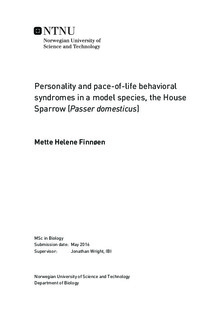| dc.description.abstract | Consistent individual differences in behaviour ( animal personality ) may be favoured by natural selection because they are driven by adaptive differences in life-history and physiology traits, constituting a pace-of-life syndrome (PoLS). Here we test this hypothesis as well as other behavioural syndrome structures using individual behavioural assays of 198 house sparrows (Passer domesticus) in captivity, and connecting individual levels of behaviour (activity in a novel environment and with a novel object and novel food) with morphological and basal metabolic rate (BMR) data. Variation between individuals in the measured behaviours and BMR, and the covariance pattern of behaviours, BMR and morphological measures were quantified using univariate tests and structural equation modelling, respectively. Activity level was the only consistent behaviour across time and contexts, and all behavioural variation was driven by an 'activity' syndrome, suggesting that our assays failed to capture any meaningful variation in neophilia or foraging innovation. There was no individual consistency in distance to the novel object or food, or in BMR. There were no sex differences in behaviour, and there was no obvious link between metabolism and personality in 'activity'. We cannot necessarily conclude from this that there is no PoLS in house sparrows, because these populations were studied only in the winter and due to BMR-based experiments there is limited reliable information on the details of their life-history traits (i.e., rates of reproduction). However, many of the most obvious phenotypic covariances hypothesised by the PoLS do not seem to be present here. There was a male-specific 'status' syndrome involving positive covariation of plumage traits and age that were related to individual quality. Again, there were surprisingly few links between 'status', individual male 'activity' behaviour and/or BMR. This suggests that the individual variation in behaviour (and BMR) measured in our sparrows is largely explained by within-individual plasticity, rather than personality or a wider pace-of-life syndrome structure. | |

